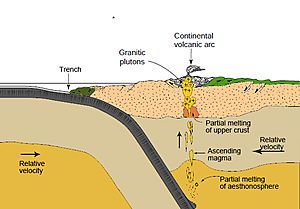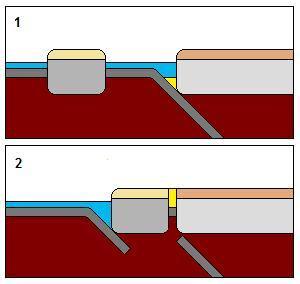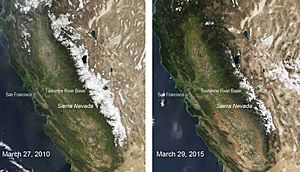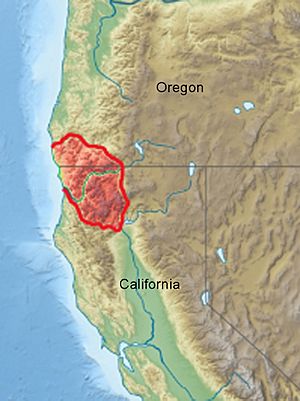Nevadan orogeny facts for kids
The Nevadan Orogeny was a huge event that built mountains along the western side of North America. It happened a long, long time ago, between about 155 and 145 million years ago, during the Middle Jurassic and Early Cretaceous periods. Imagine giant landmasses moving and crashing together!
During this mountain-building time, two main things were happening. First, an "Andean-type" mountain range grew. This happened because the Farallon oceanic plate was slowly sliding (or subducting) underneath the North American Plate. Think of one giant conveyor belt of rock diving under another. Later, more land pieces, called terranes, crashed into North America. These pieces were like small islands or volcanic arcs that were too strong to be pulled under. They got "glued" onto the continent in a "Cordilleran-type" mountain-building process.
The main mountains formed by the Nevadan Orogeny are the Klamath Mountain range and the Sierra Nevada. Most of the squishing and folding of rocks happened in the western parts of these mountains. This deformation was mainly from the Nevadan Orogeny, not from later events. The rocks in the Klamath Mountains and the Sierra Nevada are very similar, showing they were both shaped by this same big event. Compared to other mountain-building events around the world, the Nevadan Orogeny happened quite fast, in only about 10 million years!
Contents
How the Mountains Formed
The Nevadan Orogeny started when a continental volcanic arc began to form. This happened because the Farallon Plate was sliding eastward beneath the North American Plate. As the oceanic plate kept sliding, it carried several oceanic arc terranes (like old island chains) towards North America. When these terranes reached the edge of the continent, they were too light to slide under. Instead, they crashed into and attached themselves to North America. This process is called accretion.
When these terranes crashed, the mud and rock between them and North America got pushed up onto the continent. This formed special rock sequences called ophiolites. You can still see these ophiolites in both the Klamath Mountains and the Sierra Nevada today. The Klamath Mountains are in northern California and southern Oregon, while the Sierra Nevada is in central California.
The crashing of these terranes created three distinct sections in the Sierra Nevada: the Western belt, the Central belt, and the Eastern belt. The Klamath Mountains have a slightly more complicated structure than the Sierra Nevada.
The Sierra Nevada Mountains
The Sierra Nevada is a famous mountain range. It was shaped significantly by the Nevadan Orogeny.
Western Sierra Nevada Belt
The rocks in the Western belt are mostly sedimentary rocks, like greywacke and mudstone. These rocks have been squished and folded. In the southern part of this belt, the rocks show a lot of folding. The Western belt is usually separated from the Central belt by a large crack in the Earth called the Melones fault zone. This fault also marks a difference in the metamorphic rocks (rocks changed by heat and pressure) between the two belts.
Scientists believe the Western belt rocks are part of the Slate Creek terrane. This terrane attached itself to North America about 150 million years ago. The age of these rocks was figured out using a method called potassium-argon dating. You can also find many rock formations called dikes in the western foothills of the Sierra Nevada. These dikes are younger, from about 148 to 155 million years ago. They might have formed when the North American plate changed its direction of movement.
Central Sierra Nevada Belt
The Central belt of the Sierra Nevada is made of rocks from the Tuolumne River terrane. This terrane attached to North America even earlier, more than 150 million years ago. The Central belt has two main areas: the Calaveras greenschist complex and the Shoo Fly complex.
The Calaveras greenschist complex is in the western part of the Central belt. It's mostly made of volcanic arc rocks, with some chert and argillite. East of that is the Shoo Fly complex, which is mostly quartz sandstone, with some limestone and phyllite. Dating shows the Tuolumne River terrane is between 190 and 170 million years old. When this terrane crashed, there would have been a lot of folding and pushing of rocks near the collision zone. However, most of this deformation was limited to the Tuolumne River Terrane itself, with very little change seen in the Eastern belt.
Eastern Sierra Nevada Belt

The Eastern belt of the Sierra Nevada contains the Northern Sierra Terrane. This terrane formed from volcanoes at the western edge of North America. These volcanoes were caused by an oceanic plate sliding underneath the continent. This is like the "Andean" style of mountain building, where a plate slides deep under the Earth (about 110 kilometers). This causes the rock to melt, especially with the help of water (called Flux melting). The melted rock then rises to the surface, creating large rock bodies (batholiths) and volcanoes, which build up mountains.
While the western and central parts of the Sierra Nevada show a lot of rock deformation, the Eastern belt shows very little from the Nevadan Orogeny. Scientists found this by looking at dikes that cut through the rocks. These dikes were mostly unchanged. They were dated to be between 169 and 209 million years old, meaning they formed long before the Nevadan Orogeny's deformation. This shows that most of the mountain-building action happened on the western side of the Sierra Nevada.
The Klamath Mountains
The Klamath Mountains tell a similar story to the Sierra Nevada. They also formed from many different pieces of land (island arc terranes) crashing and attaching. The current idea for how the Klamath Mountains formed involves several steps.
First, volcanoes erupted on the western coast of North America, creating the Western Hayfork Terrane. After this terrane formed, the area stretched out, and molten rock (mafic dikes) pushed into the ground around 160 million years ago. When the stretching stopped, the area began to squeeze again. This closed a small basin behind the volcanic arc (a Back-arc basin) and pushed up the ophiolite sequences we see today, like the Josephine Ophiolite (about 155 million years old).
As the landmasses kept pushing together (convergence), more dikes and flat sheets of rock (sills) were pushed into the Josephine Ophiolite around 153 million years ago. The Josephine Ophiolite is the youngest of these attached rock sequences in the Klamath Mountains, dated between 155 and 150 million years old using different dating methods. Instead of being pushed on top of North America, the Josephine Ophiolite was pushed underneath and then later brought back up to the surface (exhumed).
The Klamath Mountains also have two other large rock bodies, the Abrams and Salmon mica schists, which were attached during the Nevadan Orogeny. These are part of the Stuart Fork Formation. The age of the metamorphism (rock change) in the Stuart Fork Formation was determined to be about 148 million years old. This metamorphism happened when the older Abrams and Salmon mica schists were pushed on top of the Stuart Fork rocks near the end of the Nevadan Orogeny.
When Things Happened in the Sierra Nevada and Klamath Mountains
Both the Sierra Nevada and the Klamath Mountains were formed by the Nevadan Orogeny, which involved volcanic arcs and the attachment of oceanic terranes between 155 and 145 million years ago.
- Around the same time the Eastern belt of the Sierra Nevada was forming, the Western Hayfork Terrane in the Klamath Mountains was also being built.
- As the Nevadan Orogeny continued, the Tuolumne River Terrane was attached to the Sierra Nevada. This happened at about the same time the Josephine Ophiolite formed in the Klamath Mountains (150-155 million years ago).
- In the final stages of the mountain building, the sedimentary rocks of the Western belt were attached to the Sierra Nevada. At the same time, the Abrams and Salmon mica schists were pushed on top of the Stuart Fork Formation in the Klamath Mountains.




